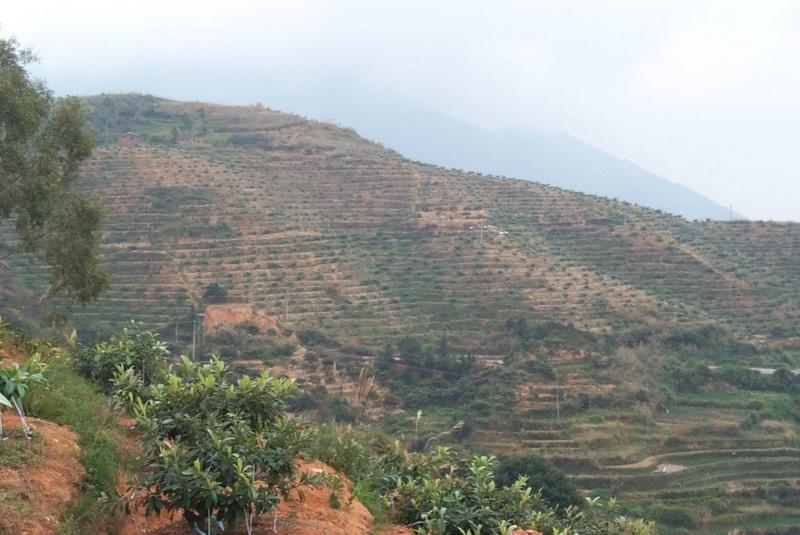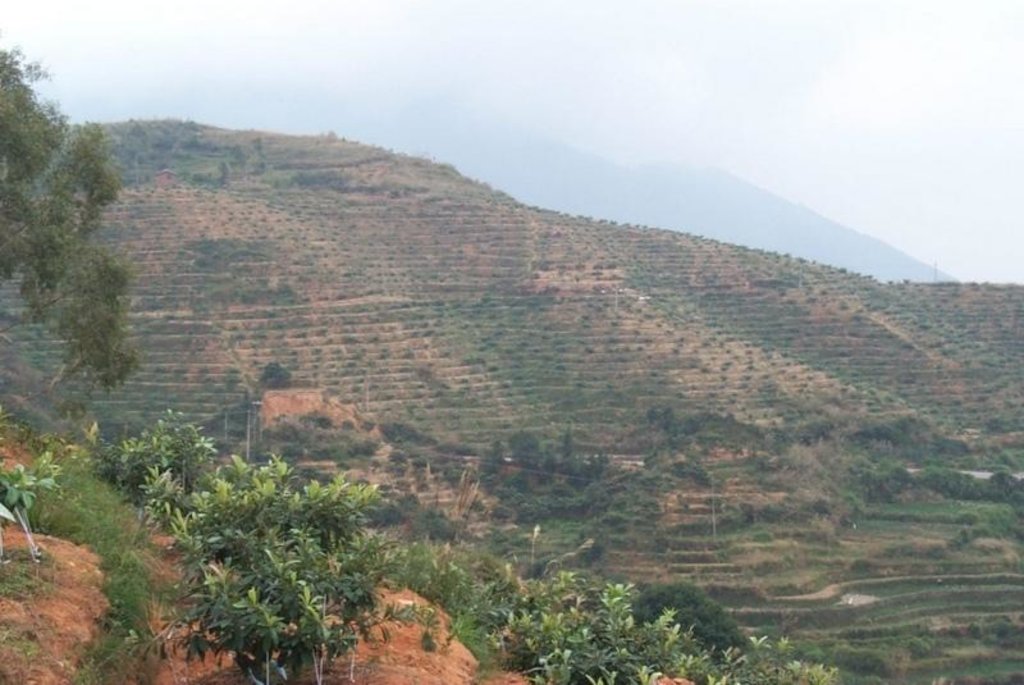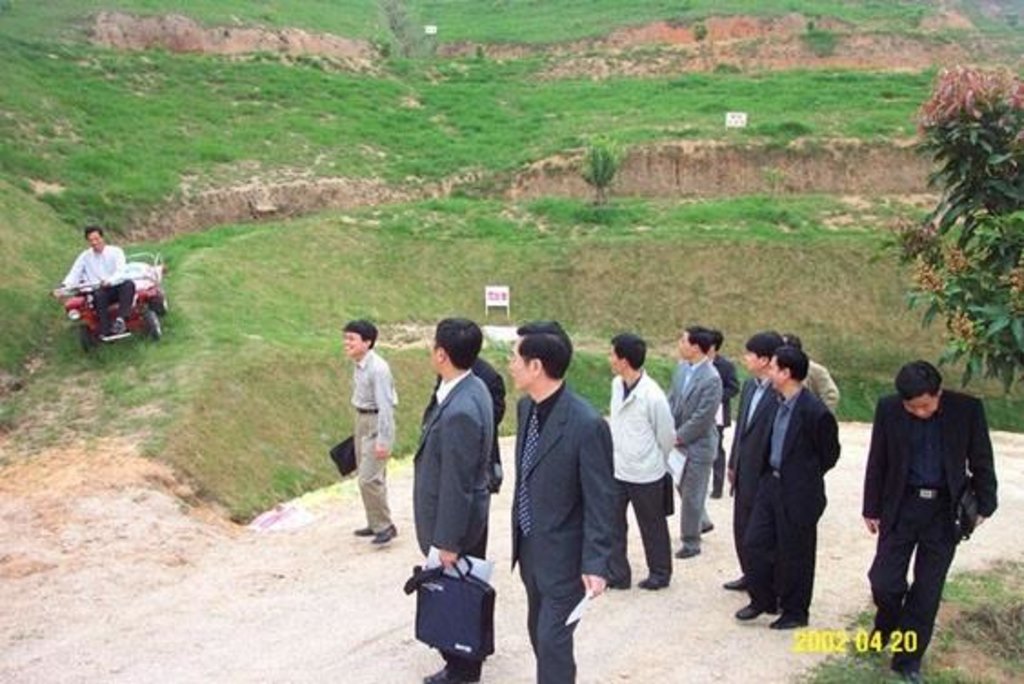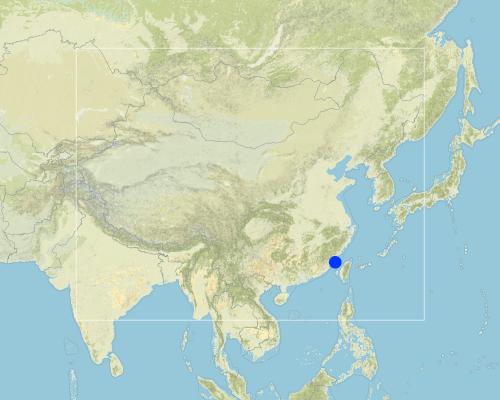Orchard Rehabilitation [China]
- Criação:
- Atualização:
- Compilador/a: Unknown User
- Editor: –
- Revisor: David Streiff
Longan Rehabilitation
technologies_981 - China
Veja as seções
Expandir tudo Recolher tudo1. Informação geral
1.3 Condições em relação ao uso da informação documentada através de WOCAT
Quando os dados foram compilados (no campo)?
26/12/1997
O/a compilador/a e a(s) pessoa(s) capacitada(s) aceitam as condições relativas ao uso de dados documentados através da WOCAT:
Sim
1.5 Referência ao(s) questionário(s) sobre as abordagens da GST
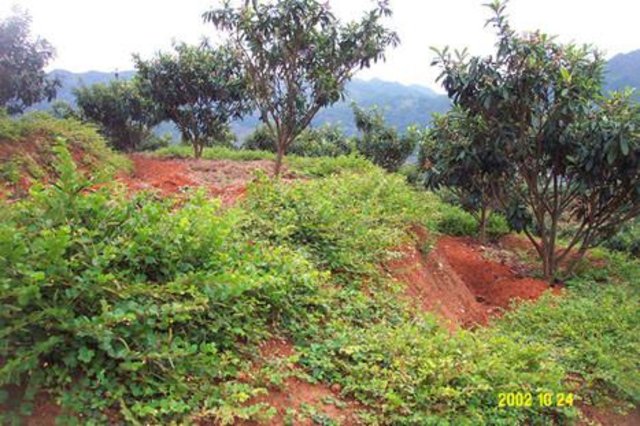
Front Bank, Back Ditch on Contour Terraces [China]
Using contour principle, constructing terraces with the front bank and back ditch in order to control soil & water erosion.
- Compilador/a: Unknown User
2. Descrição da tecnologia de GST
2.1 Descrição curta da tecnologia
Definição da tecnologia:
Contour terrace protection with front bank and three ditches in orchard rehabilitation.
2.2 Descrição detalhada da tecnologia
Descrição:
There is sufficient rainfall in this area and runoff often destroys the existing terraces causing much cost for maintaining. Sluice system on the terraces is important. This technology of the contour terrace protection is to build front bank and three ditches on terraces in order to solve this problem. The method is that building front bank on a terrace edge and digging a ditch on the back terrace as well as digging a ditch upright the terrace along a relatively low rill to induct overflow out.
2.3 Fotos da tecnologia
2.5 País/região/locais onde a tecnologia foi aplicada e que estão cobertos nesta avaliação
País:
China
Região/Estado/Província:
Fujian
Map
×2.6 Data da implementação
Caso o ano exato seja desconhecido, indique a data aproximada:
- mais de 50 anos atrás (tradicional)
2.7 Introdução da tecnologia
Especifique como a tecnologia foi introduzida:
- através de projetos/intervenções externas
Comentários (tipos de projeto, etc.):
Experiences from the farmers' over years practice.
3. Classificação da tecnologia de GST
3.2 Tipo(s) atualizado(s) de uso da terra onde a tecnologia foi aplicada

Terra de cultivo
- Cultura anual
- Cultura perene (não lenhosa)
Principais plantações (colheitas para venda e consumo próprio):
perennial fruit trees. Rice-peanut-sweat potato etc.
Comentários:
Major land use problems (compiler’s opinion): Lack of scientific planning, irrational development of the hilly and mountain areas causing serious soil loss and land degradation as well as yield decrease.
Major land use problems (land users’ perception): Low yield and much more input (fertilizer, pesticides etc.) needed to obtain the same production.
3.3 Mais informações sobre o uso da terra
Abastecimento de água para a terra na qual a tecnologia é aplicada:
- Misto de precipitação natural-irrigado
Comentários:
Water supply also rainfed
Número de estações de cultivo por ano:
- 2
Especifique:
Longest growing period in days: 365Longest growing period from month to month: Jan - Dec
3.4 Grupo de GST ao qual pertence a tecnologia
- Medidas de curva de nível
3.5 Difusão da tecnologia
Especifique a difusão da tecnologia:
- Uniformemente difundida numa área
Caso a tecnologia seja uniformemente difundida numa área, indique a área coberta aproximada:
- 1-10 km2
Comentários:
Total area covered by the SLM Technology is 2 m2.
This is a experimental and demonstrating area for applying the "Three Ditches on Terrace" technology.
3.6 Medidas de GST contendo a tecnologia

Medidas vegetativas
- V1: cobertura de árvores/arbustos
Comentários:
Type of agronomic measures: mulching, contour tillage
3.7 Principais tipos de degradação da terra abordados pela tecnologia

Erosão do solo pela água
- Wt: Perda do solo superficial/erosão de superfície

Deteriorização química do solo
- Cn: declínio de fertilidade e teor reduzido de matéria orgânica (não causado pela erosão)
Comentários:
Main type of degradation addressed: Wt: loss of topsoil / surface erosion
Secondary types of degradation addressed: Cn: fertility decline and reduced organic matter content
Main causes of degradation: other natural causes (avalanches, volcanic eruptions, mud flows, highly susceptible natural resources, extreme topography, etc.) specify, education, access to knowledge and support services (lack of knowledge)
Secondary causes of degradation: other human induced causes (specify) (agricultural causes), poverty / wealth (lack of captial)
3.8 Redução, prevenção ou recuperação da degradação do solo
Especifique o objetivo da tecnologia em relação a degradação da terra:
- Reduzir a degradação do solo
4. Especificações técnicas, implementação de atividades, entradas e custos
4.2 Especificações técnicas/ explicações do desenho técnico
Technical knowledge required for field staff / advisors: moderate
Technical knowledge required for land users: low
Main technical functions: control of dispersed runoff: impede / retard, Control / improvement of drainage
Secondary technical functions: control of raindrop splash, improvement of ground cover
Mulching
Material/ species: peanut and legume crop
Quantity/ density: 30 /m2
Remarks: layout
Contour tillage
Material/ species: layout
Fruit trees / shrubs species: longan trees
Perennial crops species: peanut
Slope (which determines the spacing indicated above): 30.00%
If the original slope has changed as a result of the Technology, the slope today is (see figure below): 2.00%
Gradient along the rows / strips: 25.00%
Construction material (earth): easy to get, simple techniques, low prices, short life
Construction material (stone): trong enough, long life, and easy to construct
Slope (which determines the spacing indicated above): 15.00%
If the original slope has changed as a result of the Technology, the slope today is: 0.00%
Lateral gradient along the structure: 60.00%
For water harvesting: the ratio between the area where the harvested water is applied and the total area from which water is collected is: 1:60.00
Vegetation is used for stabilisation of structures.
4.3 Informação geral em relação ao cálculo de entradas e custos
Especifique a moeda utilizada para os cálculos de custo:
- Dólares norte-americanos
Indique a média salarial da mão-de-obra contratada por dia:
3.00
4.4 Atividades de implantação
| Atividade | Tipo de medida | Periodicidade | |
|---|---|---|---|
| 1. | plant the fruit trees | Vegetativo | spring |
| 2. | peanut | Vegetativo | spring |
| 3. | flower and grass | Vegetativo | spring |
| 4. | digging drainage ditch | Estrutural | spring |
| 5. | constructing front bank | Estrutural | spring |
| 6. | building contour terrace | Estrutural | spring |
4.5 Custos e entradas necessárias para a implantação
Comentários:
Duration of establishment phase: 72 month(s)
4.6 Atividades recorrentes/manutenção
| Atividade | Tipo de medida | Periodicidade/frequência | |
|---|---|---|---|
| 1. | cultivation | Agronômico | dry and raining season / 2 times a year |
| 2. | harvest | Agronômico | summer and fall / 2 times a year |
| 3. | irrigation | Vegetativo | spring /timely |
| 4. | control of pest and disease | Vegetativo | spring /growing season |
| 5. | fertilization | Vegetativo | spring /twice a year |
| 6. | weeding | Vegetativo | spring /twice a year |
| 7. | maintaining the drainage ditch | Estrutural | free time/ |
| 8. | maintaining the front bank | Estrutural | free time/ |
4.7 Custos e entradas necessárias pata a manutenção/atividades recorrentes (por ano)
Comentários:
Area of the terraces.
4.8 Fatores mais importantes que afetam os custos
Descreva os fatores mais determinantes que afetam os custos:
Terrace sizes such as length, width, height etc.
5. Ambiente natural e humano
5.1 Clima
Precipitação pluviométrica anual
- <250 mm
- 251-500 mm
- 501-750 mm
- 751-1.000 mm
- 1.001-1.500 mm
- 1.501-2.000 mm
- 2.001-3.000 mm
- 3.001-4.000 mm
- > 4.000 mm
Zona agroclimática
- úmido
5.2 Topografia
Declividade média:
- Plano (0-2%)
- Suave ondulado (3-5%)
- Ondulado (6-10%)
- Moderadamente ondulado (11-15%)
- Forte ondulado (16-30%)
- Montanhoso (31-60%)
- Escarpado (>60%)
Formas de relevo:
- Planalto/planície
- Cumes
- Encosta de serra
- Encosta de morro
- Sopés
- Fundos de vale
Zona de altitude:
- 0-100 m s.n.m.
- 101-500 m s.n.m.
- 501-1.000 m s.n.m.
- 1.001-1.500 m s.n.m.
- 1.501-2.000 m s.n.m.
- 2.001-2.500 m s.n.m.
- 2.501-3.000 m s.n.m.
- 3.001-4.000 m s.n.m.
- > 4.000 m s.n.m.
Indique se a tecnologia é aplicada especificamente em:
- Não relevante
Comentários e outras especificações sobre a topografia:
slopes on average also steep
land forms also mountain slopes.
5.3 Solos
Profundidade do solo em média:
- Muito raso (0-20 cm)
- Raso (21-50 cm)
- Moderadamente profundo (51-80 cm)
- Profundo (81-120 cm)
- Muito profundo (>120 cm)
Textura do solo (solo superficial):
- Grosso/fino (arenoso)
- Fino/pesado (argila)
Matéria orgânica do solo superficial:
- Médio (1-3%)
- Baixo (<1%)
Caso disponível anexe a descrição completa do solo ou especifique as informações disponíveis, p. ex. tipo de solo, PH/acidez do solo, nitrogênio, capacidade de troca catiônica, salinidade, etc.
soil fertility is medium, low is ranked second highest and high is ranked as lowest.
Soil drainage / infiltration is medium - poor
Soil water storage capacity is medium - low
5.6 Características dos usuários da terra que utilizam a tecnologia
Rendimento não agrícola:
- 10-50% de toda renda
Nível relativo de riqueza:
- Média
- Rico
Nível de mecanização:
- Tração animal
- Mecanizado/motorizado
Indique outras características relevantes dos usuários da terra:
Population density: 200-500 persons/km2
Annual population growth: 0.5% - 1%
20% of the land users are rich and own 30% of the land.
80% of the land users are average wealthy and own 70% of the land.
Off-farm income specification: Additional income increased from fruit trees and cash crops planted in the SWC area.
5.8 Propriedade de terra, direitos de uso da terra e de uso da água
Propriedade da terra:
- Estado
Direitos do uso da terra:
- Indivíduo
Direitos do uso da água:
- Indivíduo
6. Impactos e declarações finais
6.1 Impactos no local mostrados pela tecnologia
Impactos ecológicos
Ciclo hídrico/escoamento
Escoamento superficial
Quantidade anterior à GST:
35
Quantidade posterior à GST:
20
Solo
Perda de solo
Quantidade anterior à GST:
15
Quantidade posterior à GST:
5
6.4 Análise do custo-benefício
Como os benefícios se comparam aos custos de implantação (do ponto de vista dos usuários da terra)?
Retornos a curto prazo:
levemente negativo
Retornos a longo prazo:
muito positivo
Como os benefícios se comparam aos custos recorrentes/de manutenção(do ponto de vista dos usuários da terra)?
Retornos a curto prazo:
neutro/balanceado
Retornos a longo prazo:
muito positivo
6.5 Adoção da tecnologia
- mais que 50%
Se disponível, determine a quantidade (número de unidades familiares e/ou área abordada):
43 households and 100 % of the area covered
Entre todos aqueles que adotaram a tecnologia, quantos adotaram espontaneamente, ou seja, sem receber nenhum incentivo material/pagamentos?
- 50-90%
Comentários:
65% of land user families have adopted the Technology with external material support
27 land user families have adopted the Technology with external material support
Comments on acceptance with external material support: estimates
35% of land user families have adopted the Technology without any external material support
16 land user families have adopted the Technology without any external material support
Comments on spontaneous adoption: estimates
There is a moderate trend towards spontaneous adoption of the Technology
Comments on adoption trend: More and more farmers are getting to know that the SWC technology can produce benefits.
Links e módulos
Expandir tudo Recolher tudoLinks

Front Bank, Back Ditch on Contour Terraces [China]
Using contour principle, constructing terraces with the front bank and back ditch in order to control soil & water erosion.
- Compilador/a: Unknown User
Módulos
Não há módulos


